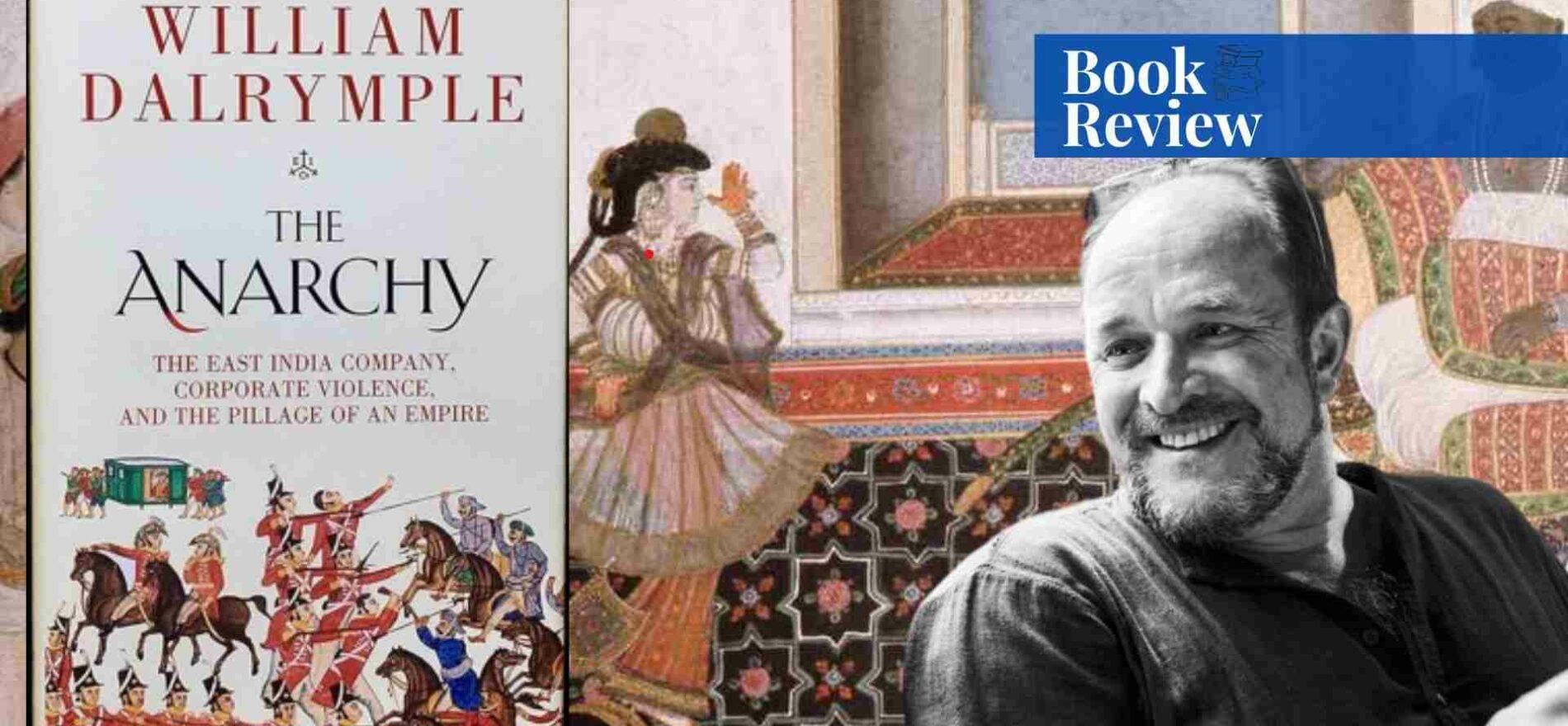‘The Anarchy: The East India Company, Corporate Violence, and the Pillage of an Empire’ by the great Scottish Historian, William Dalrymple is the story of the East India Company’s rule and plunders in the Indian Subcontinent.
Post post-medieval period has many precedents of corporate colonization outside the suburbs of the European continent. As the competition for trade and commerce grew with the exploration of new regions among European powers, they formed and funded private corporations to compete with their counterparts and carry out trade activities outside Europe. These corporations formed their armies and jostled for trade within the different regions. East India Company was one of those that came to the subcontinent. The EIC not only firmly established trade routes with the Indian Subcontinent, but by pitting one ruler against the other, it weakened the Indian rulers and established one of the most notorious corporate empires in the world.
William Dalrymple has a great capability to reflect on the events of European colonization in the Indian subcontinent and being a very worthy Historian and critical raconteur of historical anecdotes, he is astute in captivating the attentions of his readers. ‘The Anarchy’ is one the precedents of his remarkable work on the rise of the East India Company and its exploitation of the native people in a vicious way.
To compile this exquisite piece of writing, he took more than four years and visited various sites and museums to collect the relevant data and material. An intriguing fact about the book is that it is scribed for common readers; its prose is so wonderfully scripted that if a reader had it in their hands, they would only leave it once finished. The writing is very enchanting and the author tried to remain as objective as possible. Although the book has a rather intimidating size, the farther along that it is read, the more interesting it becomes.
The book consists of an introduction and 9 chapters. Each chapter is a detailed study of events. In the introduction, it is averred how sea trade was surging and Europeans were exploiting the resources of other nations that were being colonized. There is a succinct description of the East India Company and a few of its competing companies that were pre-eminent in that period. The book does not simply state the history of the EIC but represents an attempt to show how the corporation has changed the course of history and how it turned itself into an imperial organization that ruled the Indian Subcontinent.
Rise of East India Company
At the dawn of the 17th century, the EIC was granted the charter of free trade, the freedom to occupy and rule territories and raise revenue for the company’s private security. It was a malicious charter that allowed the exploitation of native resources and the violation of human rights. Where in Europe, after the peace of Westphalia, people were given freedom of religion, business, and the right to live according to their wishes, the colonies in America, Asia, and Africa were being deprived of such liberties and were even thought of as unequal or inferior human beings.
Europeans assaulted people of other continents with the task of civilizing them but, it was remorseless violence that cannot be shunned or folded away in the pages of history, the way they destroyed fledging nations, especially India. The East India Company was one of the most prominent corporations that set foot on Indian soil in 1608 where it was shunned by the Mughal Emperor Jahangir. They were fortunate in the sense that they obtained a permit to set up factories on the Surat and thus their fate was sealed with inevitable success.
The meteoric rise of EIC to the imperial power that it became can be classified into three phases.
First, when Mughal power was at its apogee, they merely remained traders and did not intervene in the internal affairs of the rulers. The company made a huge profit during this period and succeeded in building the fortification of their company offices.
Second, after the demise of Aurangzeb, Mughal power seeped towards decline and the EIC became powerful to such a degree that they started acting as mercenaries sometimes siding and succoring with one party, overthrowing the other and sometimes double-crossing their allies – all to accumulate power and influence. They became the crown makers and were becoming the most powerful force to exploit the people and their resources. Finally, after the two violent battles at Plessey and Boxer, the bastion came into the hands of the British and they became the rulers of India.
Decline of Indian Power
In waves of anarchy lapping at the Indian sea shores, the British were able to draw support through better security whilst their disciplined yet strategic system made the local merchants side with them rather than with their native leaders. That’s how they held their sway on the people; through these merchants who later became kingmakers. The narration of the rise to power of the East India Company is interesting. The inability to confront the British with outdated military technology fostered disunity among the Indian independent rulers and failure to raise the united army against the British led to the decline of Indian petty powers.
Whenever faced with strong resistance and the British saw themselves in a dilemma, they were prompted to make some sort of a peace deal. They kept looking for opportunities and whenever saw a breach in their enemy lines they leaped. The resistance provided by the Siraj ud Daulah, Haider Ali, and Tippu Sultan somehow tried to stagnate the British in their forts but the treacheries of nobles and military generals inside the lines of India gave way to the success of the British.
What proved to be the fatal blow to the already dwindling economy of India was the Allahabad Treaty between Emperor Shah Alam II and Lord Clive which gave the Mughal seal of legitimacy to the expansionist and imperial intentions of the EIC in India. What followed was relentless plunder, anarchy, distortion, and complete dehumanization of the Indians especially the Bengalis who faced a monstrous famine in the 1770s which lasted for over 3 years and claimed more than 4 million lives. The British seldom cared about the demise of people under their rule, even when it was happening in hundreds of thousands.
Exploitation of the Indian Subcontinent
Anarchy on Indian soil and other regions of the world led to the Great Divergence. India was one of the best world economies as mentioned by Nick Robbins in ‘The Corporation that Changed the World’; it accounts for the size of the Indian economy which was one-fourth of the entire world; however, it became crippled in the aftermath of the 18th and 19th centuries.
Indian states of Mysore and Bengal had the world’s best industries and the British had a fear of their overflow of silver to India so they started vanquishing the bases of industries in Bengal. Bengal became feeble and dependent on other states and was vulnerable to famine many times as mentioned above. One factor of industrial divergence from Indian soil to Europeans was the corporate exploitation of the indigenous people’s properties and businesses. The proponents of liberalism and capitalism had no qualms about the British high tariffs on cotton products from the subcontinent.
‘The Anarchy’ reflects on the corporate pillage that ransacked the region. It is not astonishing that the empire backed the corporation in pillaging and plundering the people as many members of parliament also had shares in the stocks of the company. Corporations not only looted but also made locals labor for very low wages which led to mutinies in many regions of the subcontinent. It can be reflected from the history of the EIC that not only did corporations exploit and loot before the modern age but set the basis for future corporate ransacking. In the incumbent era, MNC structures and methods have changed but the undertones of structural violence and exploitation are continuous.
Dalrymple highlights an important point in ‘The Anarchy’ to emphasize that companies are still taking unfair advantage of human morale. Ergo, it can be inferred that instead of learning from history and shaping a peaceful world order for the future, MNCs and TNCs are at their zenith to spoil people and their socio-cultural norms for materialistic purposes. Facebook, Twitter, Google, and YouTube are some of these very industries/organizations that are degrading and propelling humans towards impending mutiny by the proletariat classes though the path to rebellion could be different this time.
Conclusion
The EIC became so powerful that it could sway influence inside the British parliament. It became capable of passing laws by the British parliament that suited it to rob the people. New constitutions were made for the privileges of cooperating officials. The present-day circumstances reflect the same power dynamics that are unlawful and legitimized by corporations due to their influence in law-making bodies.
Dalrymple’s account of the history of the EIC is the remarkable precursor of modern-day corporate pillaging. One can see how the corporations held sway in the parliaments and imperial zones. ‘The Anarchy’ is an exquisite interpretation of corporate exploitation. The question remains whether these corporations will keep holding the power or will the masses become conscious of the imminent threat that these corporations pose against them.
If you want to submit your articles, research papers, and book reviews, please check the Submissions page.
The views and opinions expressed in this article/paper are the author’s own and do not necessarily reflect the editorial position of Paradigm Shift.



















